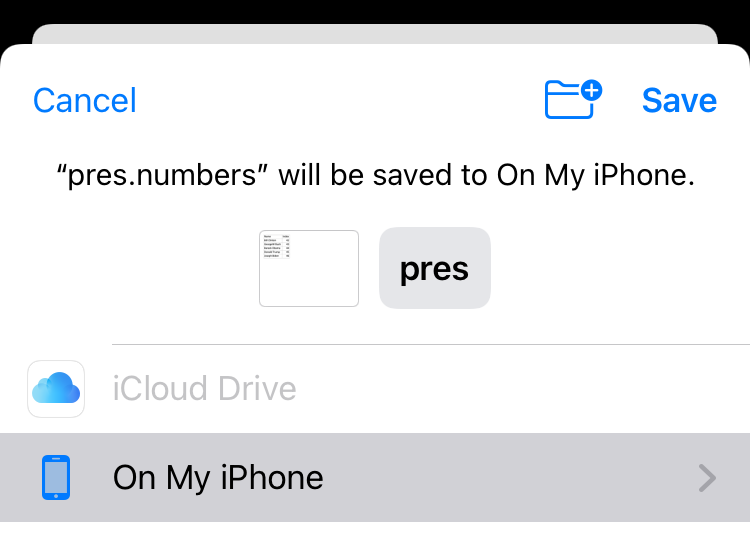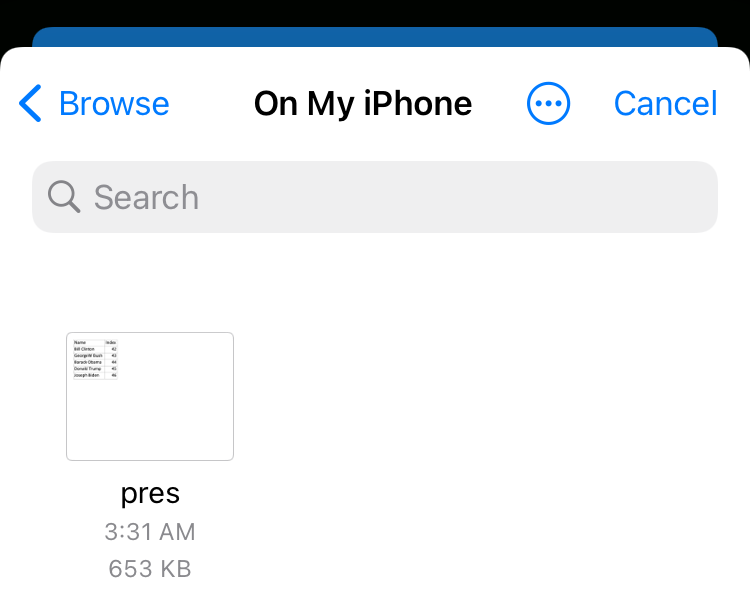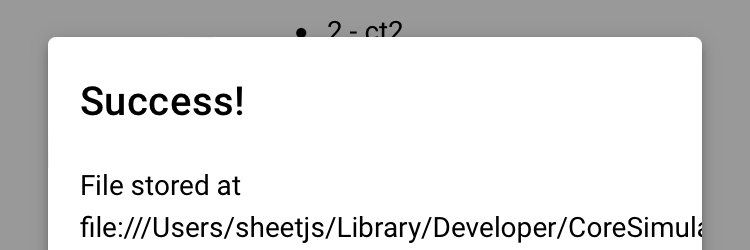Data in Quasar Apps
Quasar is a VueJS framework for building iOS and Android apps with the Cordova platform.
SheetJS is a JavaScript library for reading and writing data from spreadsheets.
This demo uses Quasar and SheetJS to process data and generate spreadsheets. We'll explore how to load SheetJS in an Quasar app and use Quasar and Cordova features to extract data from, and write data to, spreadsheets on the device.
The "Demo" creates an app that looks like the screenshots below:
| iOS | Android |
|---|---|
|
|
This demo was tested in the following environments:
Real Devices
| OS | Device | Quasar | Date |
|---|---|---|---|
| Android 34 | NVIDIA Shield | 2.18.1 | 2025-04-17 |
| iOS 15.1 | iPad Pro | 2.18.1 | 2025-04-17 |
Simulators
| OS | Device | Quasar | Dev Platform | Date |
|---|---|---|---|---|
| Android 35 | Pixel 9 Pro XL | 2.18.1 | darwin-arm | 2025-04-17 |
| iOS 18.2 | iPhone 16 Pro Max | 2.18.1 | darwin-arm | 2025-04-17 |
| Android 36 | Pixel 9 Pro XL | 2.18.1 | win11-x64 | 2025-04-17 |
Integration Details
The SheetJS NodeJS Module can be imported from any component or script in the app.
This demo will use the Quasar ViteJS starter project with VueJS and Cordova.
The starter places the backing Cordova project in the src-cordova folder.
The complete solution uses cordova-plugin-file for file operations. It can
be installed from the Cordova folder:
cd src-cordova
cordova plugin add cordova-plugin-file
cd ..
Reading data
The QFile1 component presents an API reminiscent of File Input elements:
<q-file label="Load File" filled label-color="orange" @input="updateFile"/>
When binding to the input element, the callback receives an Event object.
Using standard DOM operations, the file data can be pulled into an ArrayBuffer
and parsed using the SheetJS read method2. read returns a workbook3
object that holds data and metadata for each worksheet.
This snippet reads a workbook, pulls the first worksheet, generates an array of
objects using the SheetJS sheet_to_json4 method, and updates state:
import { read } from 'xlsx';
// assuming `todos` is a standard VueJS `ref`
async function updateFile(v) { try {
// `v.target.files[0]` is the desired file object
const files = (v.target as HTMLInputElement).files;
if(!files || files.length == 0) return;
// read first file
const wb = read(await files[0].arrayBuffer());
// get data of first worksheet as an array of objects
const data = utils.sheet_to_json(wb.Sheets[wb.SheetNames[0]]);
// update state
todos.value = data.map(row => ({id: row.Index, content: row.Name}));
} catch(e) { console.log(e); } }
Writing data
Starting from an array of objects, the SheetJS json_to_sheet method5
generates a SheetJS worksheet object. The book_append_sheet and book_new
helper functions6 create a SheetJS workbook object that can be exported:
import { utils } from 'xlsx';
// assuming `todos` is a VueJS ref whose value is an array of objects
const ws = utils.json_to_sheet(todos.value);
const wb = utils.book_new();
utils.book_append_sheet(wb, ws, "SheetJSQuasar");
The SheetJS write function7 with the option type: "buffer" will generate
Uint8Array objects that can be converted to blobs and exported:
import { write } from 'xlsx';
// on iOS and android, `XLSX.write` with type "buffer" returns a `Uint8Array`
const u8: Uint8Array = write(wb, {bookType: "xlsx", type: "buffer"});
The cordova-plugin-file API writes the data to the filesystem. The code uses
the File and Directory Entries API8:
// Request filesystem access for persistent storage
window.requestFileSystem(window.PERSISTENT, 0, function(fs) {
// Request a handle to "SheetJSQuasar.xlsx", making a new file if necessary
fs.root.getFile("SheetJSQuasar.xlsx", {create: true}, entry => {
// Request a FileWriter for writing data
entry.createWriter(writer => {
// The FileWriter API needs an actual Blob
const data = new Blob([u8], {type: "application/vnd.ms-excel"});
// This callback is called if the write is successful
writer.onwriteend = () => {
// TODO: show a dialog
};
// writer.onerror will be invoked if there is an error in writing
// write the data
writer.write(data);
});
});
});
Demo
The demo draws from the ViteJS example. Familiarity with VueJS and TypeScript is assumed.
Platform Setup
- Ensure all of the dependencies are installed. Install the CLI globally:
npm i -g @quasar/cli cordova
In some systems, the command must be run as the root user:
sudo npm i -g @quasar/cli cordova
Installation Notes (click to show)
Quasar requires Java 17
Base Project
- Create a new app:
npm init quasar
When prompted:
- "What would you like to build?":
App with Quasar CLI, let's go! - "Project folder":
SheetJSQuasar - "Pick script type":
Typescript - "Pick Quasar App CLI variant":
Quasar App CLI with Vite - "Package name": (press Enter, it will use the default
sheetjsquasar) - "Project product name":
SheetJSQuasar - "Project description":
SheetJS + Quasar - "Pick a Vue component style":
Composition API with <script setup> - "Pick your CSS preprocessor":
None - "Check the features needed for your project": Deselect everything (scroll down to each selected item and press Space)
- "Install project dependencies":
Yes, use npm
- Install dependencies:
cd SheetJSQuasar
npm i
npm i --save https://cdn.sheetjs.com/xlsx-0.20.3/xlsx-0.20.3.tgz
- Set up Cordova:
npx cordova telemetry off
npx quasar mode add cordova
npx quasar mode remove capacitor
When prompted, enter the app id org.sheetjs.quasar.
- Add the Dialog plugin to the
pluginsarray inquasar.config.ts:
// Quasar plugins
plugins: ['Dialog']
- Download
IndexPage.vueand replace the existing page scriptsrc/pages/IndexPage.vue:
curl -L -o src/pages/IndexPage.vue https://docs.sheetjs.com/quasar/IndexPage.vue
Android
- Create the Android project:
cd src-cordova
npx cordova platform add android
npx cordova plugin add cordova-plugin-wkwebview-engine
npx cordova plugin add cordova-plugin-file
cd ..
- Start the simulator:
npx quasar dev -m cordova -T android
If prompted to select an external IP, press Enter.
If the app is blank or not refreshing, delete the app and close the simulator, then restart the development process.
In some test runs, the command failed with a Gradle error
Could not find an installed version of Gradle either in Android Studio,
or on your system to install the gradle wrapper. Please include gradle
in your path, or install Android Studio
Gradle (the complete version) must be extracted and the
bin folder must be added to the user PATH variable. After adding to PATH,
launch a new PowerShell or Command Prompt window and run the command.
To test that reading works:
- Download https://docs.sheetjs.com/pres.numbers
- Open the Downloads folder in Finder or Explorer
- Click and drag
pres.numbersfrom the window into the simulator. - Tap "Load File", tap the
≡icon, tap "Downloads" and selectpres.numbers.
To test that writing works:
- Tap "Save File". You will see a popup with a location.
- Pull the file from the simulator and verify the contents:
adb exec-out run-as org.sheetjs.quasar cat files/files/SheetJSQuasar.xlsx > /tmp/SheetJSQuasar.xlsx
npx xlsx-cli /tmp/SheetJSQuasar.xlsx
PowerShell file redirects will corrupt binary data. In Windows, commands must be run from a Command Prompt session.
iOS
- Create the iOS project:
cd src-cordova
npx cordova platform add ios
npx cordova plugin add cordova-plugin-wkwebview-engine
npx cordova plugin add cordova-plugin-file
cd ..
If there is an error Could not load API for iOS project, it needs to be reset:
npx cordova platform rm ios
npx cordova platform add ios
npx cordova plugin add cordova-plugin-file
- Enable file sharing and make the documents folder visible in the iOS app.
The following lines must be added to
src-cordova/platforms/ios/SheetJSQuasar/SheetJSQuasar-Info.plist:
<plist version="1.0">
<dict>
<key>UIFileSharingEnabled</key>
<true/>
<key>LSSupportsOpeningDocumentsInPlace</key>
<true/>
<key>CFBundleDevelopmentRegion</key>
(The root element of the document is plist and it contains one dict child)
- Start the development server:
npx quasar dev -m cordova -T ios
If prompted to select an external IP, press Enter.
If the app is blank or not refreshing, delete the app and close the simulator, then restart the development process.
The app should now show two buttons at the bottom:

If the app is blank or not refreshing, delete the app and close the simulator, then restart the development process.
To test that reading works:
- Download https://docs.sheetjs.com/pres.numbers
- In the simulator, click the Home icon to return to the home screen
- Click on the "Files" icon
- Click and drag
pres.numbersfrom a Finder window into the simulator.

- Make sure "On My iPhone" is highlighted and select "Save"
- Click the Home icon again then select the
SheetJSQuasarapp - Click the "Load" button, then select "Choose File" and select
pres:

Once selected, the screen should refresh with new contents.
To test that writing works:
-
Close the app in the simulator and re-launch the app.
-
Click "Save File". You will see a popup with a location:

- Find the file and verify the contents are correct. Run in a new terminal:
find ~/Library/Developer/CoreSimulator -name SheetJSQuasar.xlsx |
while read x; do echo "$x"; npx xlsx-cli "$x"; done
Since the contents reverted, you should see
SheetJSQuasar
id,content
1,ct1
2,ct2
3,ct3
4,ct4
5,ct5
-
Use "Load File" to select
pres.numbersagain. Wait for the app to refresh. -
Click "Save File", then re-run the command:
find ~/Library/Developer/CoreSimulator -name SheetJSQuasar.xlsx |
while read x; do echo "$x"; npx xlsx-cli "$x"; done
The contents from pres.numbers should show up now, with a new header row:
SheetJSQuasar
id,content
42,Bill Clinton
43,GeorgeW Bush
44,Barack Obama
45,Donald Trump
46,Joseph Biden
Android Device
-
Close all open emulators and simulators.
-
Disconnect any iOS or Android devices connected to the computer.
-
Connect the Android device to the computer.
-
Start the dev process:
npx quasar dev -m cordova -T android
If prompted to select an external IP, press Enter.
- Test the application:
- Press the Home button (or swipe up with one finger) and switch to Browser.
- Download https://docs.sheetjs.com/pres.numbers
- Press the Home button (or swipe up with one finger) and select the
SheetJSQuasarapp - Tap the "Load" button, then select "Choose File" and select the downloaded
pres.numbers
The table will update with new data.
The "Save File" process will write files. However, Android 30+ requires special methods ("Storage Access Framework") that are not implemented in Quasar.
iOS Device
-
Close all open emulators and simulators.
-
Disconnect any iOS or Android devices connected to the computer.
-
Connect the iOS device to the computer.
-
Open the Xcode project:
open src-cordova/platforms/ios/SheetJSQuasar.xcodeproj
Select "SheetJSQuasar" in the Navigator. In the main pane, select "Signing & Capabilities" and ensure a Team is selected. Save and close the project.
- Start the dev process:
npx quasar dev -m cordova -T ios
If prompted to select an external IP, press Enter.
- Test the application:
- Press the Home button (or swipe up with one finger) and switch to Safari.
- Download https://docs.sheetjs.com/pres.numbers
- Press the Home button (or swipe up with one finger) and select the
SheetJSQuasarapp - Tap the "Load" button, then select "Choose File" and select the downloaded
pres.numbers
The table will update with new data.
- Tap "Save File"
- Press the Home button (or swipe up with one finger) and switch to Files.
- Tap
<until the main "Browse" window is displayed, then select "On My iPhone" - Look for the "SheetJSQuasar" folder and tap
SheetJSQuasar.xlsx.
If Numbers is installed on the device, it will display the contents of the new file.
Footnotes
-
See "File Picker" in the Quasar documentation. ↩
-
See "SheetJS Data Model" for more details on workbooks, worksheets, and other concepts. ↩
-
See "Workbook Helpers" in "Utilities" for details on
book_newandbook_append_sheet. ↩ -
See
requestFileSystemin the MDN Web Docs for more details. ↩

